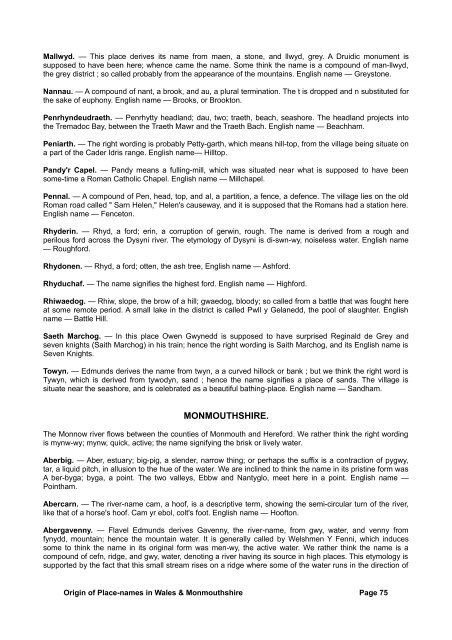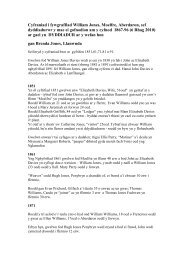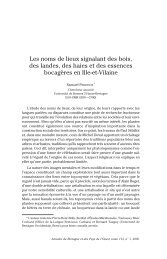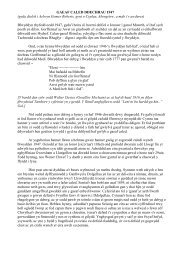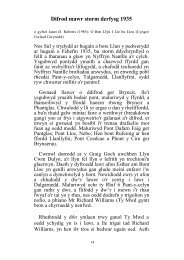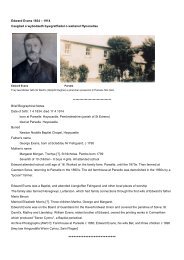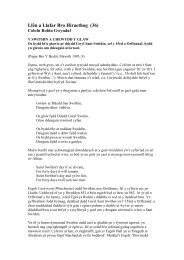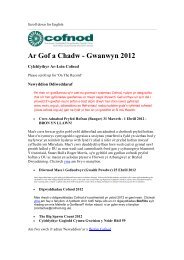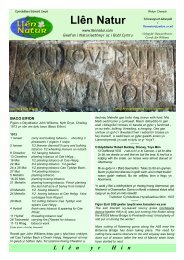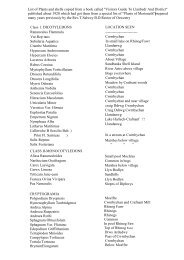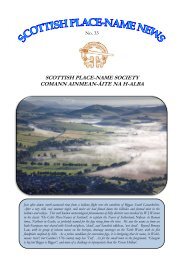Mallwyd. — This <strong>place</strong> derives its name from maen, a stone, <strong>and</strong> llwyd, grey. A Druidic monument issupposed to have been here; whence came <strong>the</strong> name. Some th<strong>in</strong>k <strong>the</strong> name is a compound <strong>of</strong> man-llwyd,<strong>the</strong> grey district ; so called probably from <strong>the</strong> appearance <strong>of</strong> <strong>the</strong> mounta<strong>in</strong>s. English name — Greystone.Nannau. — A compound <strong>of</strong> nant, a brook, <strong>and</strong> au, a plural term<strong>in</strong>ation. The t is dropped <strong>and</strong> n substituted for<strong>the</strong> sake <strong>of</strong> euphony. English name — Brooks, or Brookton.Penrhyndeudraeth. — Penrhytty headl<strong>and</strong>; dau, two; traeth, beach, seashore. The headl<strong>and</strong> projects <strong>in</strong>to<strong>the</strong> Tremadoc Bay, between <strong>the</strong> Traeth Mawr <strong>and</strong> <strong>the</strong> Traeth Bach. English name — Beachham.Peniarth. — The right word<strong>in</strong>g is probably Petty-garth, which means hill-top, from <strong>the</strong> village be<strong>in</strong>g situate ona part <strong>of</strong> <strong>the</strong> Cader Idris range. English name— Hilltop.P<strong>and</strong>y'r Capel. — P<strong>and</strong>y means a full<strong>in</strong>g-mill, which was situated near what is supposed to have beensome-time a Roman Catholic Chapel. English name — Millchapel.Pennal. — A compound <strong>of</strong> Pen, head, top, <strong>and</strong> al, a partition, a fence, a defence. The village lies on <strong>the</strong> oldRoman road called " Sarn Helen," Helen's causeway, <strong>and</strong> it is supposed that <strong>the</strong> Romans had a station here.English name — Fenceton.Rhyder<strong>in</strong>. — Rhyd, a ford; er<strong>in</strong>, a corruption <strong>of</strong> gerw<strong>in</strong>, rough. The name is derived from a rough <strong>and</strong>perilous ford across <strong>the</strong> Dysyni river. The etymology <strong>of</strong> Dysyni is di-swn-wy, noiseless water. English name— Roughford.Rhydonen. — Rhyd, a ford; otten, <strong>the</strong> ash tree, English name — Ashford.Rhyduchaf. — The name signifies <strong>the</strong> highest ford. English name — Highford.Rhiwaedog. — Rhiw, slope, <strong>the</strong> brow <strong>of</strong> a hill; gwaedog, bloody; so called from a battle that was fought hereat some remote period. A small lake <strong>in</strong> <strong>the</strong> district is called Pwll y Gelanedd, <strong>the</strong> pool <strong>of</strong> slaughter. Englishname — Battle Hill.Saeth Marchog. — In this <strong>place</strong> Owen Gwynedd is supposed to have surprised Reg<strong>in</strong>ald de Grey <strong>and</strong>seven knights (Saith Marchog) <strong>in</strong> his tra<strong>in</strong>; hence <strong>the</strong> right word<strong>in</strong>g is Saith Marchog, <strong>and</strong> its English name isSeven Knights.Towyn. — Edmunds derives <strong>the</strong> name from twyn, a a curved hillock or bank ; but we th<strong>in</strong>k <strong>the</strong> right word isTywyn, which is derived from tywodyn, s<strong>and</strong> ; hence <strong>the</strong> name signifies a <strong>place</strong> <strong>of</strong> s<strong>and</strong>s. The village issituate near <strong>the</strong> seashore, <strong>and</strong> is celebrated as a beautiful bath<strong>in</strong>g-<strong>place</strong>. English name — S<strong>and</strong>ham.MONMOUTHSHIRE.The Monnow river flows between <strong>the</strong> counties <strong>of</strong> Monmouth <strong>and</strong> Hereford. We ra<strong>the</strong>r th<strong>in</strong>k <strong>the</strong> right word<strong>in</strong>gis mynw-wy; mynw, quick, active; <strong>the</strong> name signify<strong>in</strong>g <strong>the</strong> brisk or lively water.Aberbig. — Aber, estuary; big-pig, a slender, narrow th<strong>in</strong>g; or perhaps <strong>the</strong> suffix is a contraction <strong>of</strong> pygwy,tar, a liquid pitch, <strong>in</strong> allusion to <strong>the</strong> hue <strong>of</strong> <strong>the</strong> water. We are <strong>in</strong>cl<strong>in</strong>ed to th<strong>in</strong>k <strong>the</strong> name <strong>in</strong> its prist<strong>in</strong>e form wasA ber-byga; byga, a po<strong>in</strong>t. The two valleys, Ebbw <strong>and</strong> Nantyglo, meet here <strong>in</strong> a po<strong>in</strong>t. English name —Po<strong>in</strong>tham.Abercarn. — The river-name cam, a ho<strong>of</strong>, is a descriptive term, show<strong>in</strong>g <strong>the</strong> semi-circular turn <strong>of</strong> <strong>the</strong> river,like that <strong>of</strong> a horse's ho<strong>of</strong>. Cam yr ebol, colt's foot. English name — Ho<strong>of</strong>ton.Abergavenny. — Flavel Edmunds derives Gavenny, <strong>the</strong> river-name, from gwy, water, <strong>and</strong> venny fromfynydd, mounta<strong>in</strong>; hence <strong>the</strong> mounta<strong>in</strong> water. It is generally called by Welshmen Y Fenni, which <strong>in</strong>ducessome to th<strong>in</strong>k <strong>the</strong> name <strong>in</strong> its <strong>orig<strong>in</strong></strong>al form was men-wy, <strong>the</strong> active water. We ra<strong>the</strong>r th<strong>in</strong>k <strong>the</strong> name is acompound <strong>of</strong> cefn, ridge, <strong>and</strong> gwy, water, denot<strong>in</strong>g a river hav<strong>in</strong>g its source <strong>in</strong> high <strong>place</strong>s. This etymology issupported by <strong>the</strong> fact that this small stream rises on a ridge where some <strong>of</strong> <strong>the</strong> water runs <strong>in</strong> <strong>the</strong> direction <strong>of</strong>Orig<strong>in</strong> <strong>of</strong> Place-<strong>names</strong> <strong>in</strong> Wales & Monmouthshire Page 75
Crickhowell <strong>and</strong> some <strong>in</strong> <strong>the</strong> direction <strong>of</strong> Abergavenny. The town is almost encircled by ridges <strong>and</strong>mounta<strong>in</strong>s. English name — Ridgeton.Abersychan. — Sychan is <strong>the</strong> name <strong>of</strong> <strong>the</strong> rivulet that jo<strong>in</strong>s <strong>the</strong> Afon Lwyd at <strong>the</strong> <strong>place</strong>. Sych, dry; an-a<strong>in</strong>, astream <strong>of</strong> water, a brook. We f<strong>in</strong>d a brook called Sychryd <strong>in</strong> Breconshire, <strong>and</strong> also Hepste, which is probablya corruption <strong>of</strong> Hesp-an, water that dries up. We have also Havesp; haf, summer; hesp, dry. In summer time<strong>the</strong> channels <strong>of</strong> <strong>the</strong>se rivulets dry up; hence <strong>the</strong> name. English name — Drymouth.Abertillery. — Tillery is <strong>the</strong> name <strong>of</strong> <strong>the</strong> river that flows through <strong>the</strong> <strong>place</strong>. Til implies a small th<strong>in</strong>g; air, clear,bright; gwy, water; <strong>the</strong> name, accord<strong>in</strong>g to this derivation, signifies <strong>the</strong> mouth <strong>of</strong> <strong>the</strong> small clear river. Ano<strong>the</strong>rattempt: Tel, imply<strong>in</strong>g straight; llerw, s<strong>of</strong>t, smooth; gwy, water. We are <strong>in</strong>duced to th<strong>in</strong>k <strong>the</strong> name is acompound <strong>of</strong> telor, warbler, <strong>and</strong> gwy, water; signify<strong>in</strong>g <strong>the</strong> warbl<strong>in</strong>g river. English name — Warbleton.Argoed. — A contraction <strong>of</strong> ar-y-coed, signify<strong>in</strong>g a <strong>place</strong> situated on or above a wood. Dr. O. Pughe sayscamps were fortified, on emergencies, by fell<strong>in</strong>g trees to surround <strong>the</strong>m, <strong>and</strong> one so constructed was calledArgoed. It is cognate with Arghait <strong>in</strong> Scotl<strong>and</strong>. English name — Upwood.Bassaleg. — Many conjectures have been propounded as to <strong>the</strong> <strong>orig<strong>in</strong></strong> <strong>of</strong> this name. Nennius <strong>and</strong> o<strong>the</strong>rsth<strong>in</strong>k it means Maes Aleg, <strong>the</strong> field <strong>of</strong> Alectus, signify<strong>in</strong>g elect-l<strong>and</strong>, Aleg be<strong>in</strong>g a Welshism <strong>of</strong> Alectus. It issupposed that here <strong>the</strong> famous Myrdd<strong>in</strong> was discovered by <strong>the</strong> messengers <strong>of</strong> K<strong>in</strong>g Gwr<strong>the</strong>yrn. About a milefrom <strong>the</strong> village <strong>the</strong>re is a circular entrenchment supposed to have been a Saxon camp. Some th<strong>in</strong>k <strong>the</strong>correct word<strong>in</strong>g is Bats-Aleg; baes-bais, flats or shallows, a ford; Aleg, a contraction <strong>of</strong> Alex<strong>and</strong>er. It is,accord<strong>in</strong>g to some, a corruption <strong>of</strong> nuus-yr-helyg, <strong>the</strong> field <strong>of</strong> <strong>the</strong> willows, from <strong>the</strong> abundance <strong>of</strong> willow-trees<strong>in</strong> <strong>the</strong> vic<strong>in</strong>ity. In <strong>the</strong> middle ages <strong>the</strong>re was a priory here dedicated to St. Basil, which was a cell <strong>in</strong>connection with Glastonbury Abbey. The name <strong>of</strong> <strong>the</strong> priory <strong>in</strong> full was probably Basili Ecclisia, <strong>the</strong> church <strong>of</strong>Basil. The name was ultimately contracted <strong>in</strong>to Basil-ecc, <strong>and</strong> fur<strong>the</strong>r corrupted <strong>in</strong>to Bassilech <strong>and</strong> Bassaleg.The parish church is dedicated to St. Basil. Basil-ecc is identical <strong>in</strong> mean<strong>in</strong>g with Llanbasil. English name —Basilchurch or Basilton.Bedwas. — Some derive <strong>the</strong> name from ????. Bedwas, one <strong>of</strong> <strong>the</strong> twelve sons <strong>of</strong> Helig ab Glanawg. We are<strong>in</strong>cl<strong>in</strong>ed to derive it from bedw, birch; <strong>and</strong> as, a pla<strong>in</strong> surface; signify<strong>in</strong>g a <strong>place</strong> <strong>of</strong> birch-trees. English name— Birchton.Blaenavon. — Blaen here means <strong>the</strong> source <strong>of</strong> <strong>the</strong> river; Avon, river. This <strong>place</strong> is situated near <strong>the</strong> source<strong>of</strong> <strong>the</strong> river Llwyd; hence <strong>the</strong> name. English name — Spr<strong>in</strong>gton.Bla<strong>in</strong>a. — A slight mutation <strong>of</strong> Blaenau, plural form <strong>of</strong> blaen, source. Blaenau afonydd, <strong>the</strong> sources <strong>of</strong> rivers.The name signifies a <strong>place</strong> where several streams <strong>of</strong> water commence <strong>the</strong>ir sea-ward journey. English name— Spr<strong>in</strong>gston.Bryngwyn. — The correct word<strong>in</strong>g, perhaps, is Bre<strong>in</strong> Gwyn, <strong>the</strong> supreme or royal tribunal. We do not know<strong>of</strong> any vestige <strong>of</strong> this royal court, but a British camp called " The Camp Hill " is <strong>in</strong> <strong>the</strong> parish. English name —Rexhill.Bwlch Trewyn. — Bwlch, a break or breach, a gap; generally applied to <strong>place</strong>s where mounta<strong>in</strong>s term<strong>in</strong>ate,<strong>and</strong> form a pass; Trewyn, lead<strong>in</strong>g away, persuasion. English name — Passton.Caergwent. — Caer, fortified wall, camp; gwent, a fair or open region. The name Gwent <strong>in</strong> ancient timescomprehended portions <strong>of</strong> <strong>the</strong> counties <strong>of</strong> Gloucester, Hereford, <strong>and</strong> Monmouth; <strong>and</strong> Cas gwent, or <strong>the</strong>Venta Silurum <strong>of</strong> <strong>the</strong> Romans, was <strong>the</strong> capital; but now it is conf<strong>in</strong>ed to <strong>the</strong> county <strong>of</strong> Monmouth. Englishname — Campton.Caerleon. — Caer, already expla<strong>in</strong>ed; lleon, legion. It is generally believed that <strong>the</strong> Roman station <strong>of</strong> <strong>the</strong>Second Augustan Legion was situated here, which was <strong>the</strong>n called Isca Silurum. The Silures occupied <strong>the</strong>eastern half <strong>of</strong> <strong>the</strong> country between <strong>the</strong> lower couise <strong>of</strong> <strong>the</strong> Severn <strong>and</strong> Cardigan Bay, <strong>and</strong> Isca was <strong>the</strong>reputed seat <strong>of</strong> Caractacus when leader <strong>of</strong> <strong>the</strong> Silures. Isca is <strong>the</strong> Lat<strong>in</strong> for Wysg or Usk. The Second Legionwas permanently posted here under <strong>the</strong> comm<strong>and</strong> <strong>of</strong> Vespasian, hence <strong>the</strong> name Caerlleon ar Wysg - <strong>the</strong>Camp <strong>of</strong> <strong>the</strong> Legion on <strong>the</strong> Usk. English name — Legionton.Caldicot. — Some th<strong>in</strong>k <strong>the</strong> right word<strong>in</strong>g is Galdigoed; gal, a pla<strong>in</strong>; digoed, woodless; signify<strong>in</strong>g a woodlessregion. O<strong>the</strong>rs derive it from Ch-dy-coed, a house <strong>of</strong> retreat <strong>in</strong> <strong>the</strong> woods. Isaac Taylor derives it as ????Orig<strong>in</strong> <strong>of</strong> Place-<strong>names</strong> <strong>in</strong> Wales & Monmouthshire Page 76
- Page 1 and 2:
HANDBOOK OF THE ORIGIN OF PLACE-NAM
- Page 3 and 4:
§ § § § §The Author begs to st
- Page 5 and 6:
pitiful cries of the railway offici
- Page 7 and 8:
Bishop Percy says that "in England,
- Page 9 and 10:
The city of Chester is still popula
- Page 11 and 12:
There's Cumwhitton, Cumwhinton, Cum
- Page 13 and 14:
Llwyn in its primary' sense means a
- Page 15 and 16:
PLACE-NAMES IN WALES.Wales. — The
- Page 17 and 18:
Church are generally dedicated to e
- Page 19 and 20:
think he was a contemporary of St.
- Page 21 and 22:
Rhosbeirio. — Rhos, a moor, a dry
- Page 23 and 24:
of Brecknock," states that this vic
- Page 25 and 26:
Cam cnwir ef Cwmdu,Cwm gwyn yw & n
- Page 27 and 28: Penderyn. — A corruption probably
- Page 29 and 30: Ardudwy. — Ar, upon or above; tud
- Page 31 and 32: to mark its pre-eminence over the o
- Page 33 and 34: Some think that eirw is a corruptio
- Page 35 and 36: present form — Caerfyrddin.Abergw
- Page 37 and 38: place of refuge; hence the name. En
- Page 39 and 40: Llansawyl. — The church was dedic
- Page 41 and 42: eject. The village took its name fr
- Page 43 and 44: house, and attempted to kill an inf
- Page 45 and 46: Gwydir. — Prima facie one may tak
- Page 47 and 48: Nefyn. — The church was probably
- Page 49 and 50: DENBIGHSHIRE.Anglicized form of Din
- Page 51 and 52: Llangollen. — From Collen, a sain
- Page 53 and 54: hands into their pockets to pay a c
- Page 55 and 56: Cefn. — The name signifies a ridg
- Page 57 and 58: Maesgarmon. — Named in honour of
- Page 59 and 60: Abertridwr. — Tridwr, three water
- Page 61 and 62: it is said, was originally built by
- Page 63 and 64: Cwmllynfell. — Cwm, a narrow vale
- Page 65 and 66: Gwarycaeau. — Gwdr, the nape of t
- Page 67 and 68: means a cultivated region, a vale,
- Page 69 and 70: Penrhiwfer.- Pen, head, top; rhiw,
- Page 71 and 72: Port Talbot. — So called in 1835
- Page 73 and 74: Trealaw. — This appellation was g
- Page 75 and 76: Aberdyfi. — So called from its si
- Page 77: Llanddwywe. — From Dwywau, a desc
- Page 81 and 82: Griffithstown. — This village was
- Page 83 and 84: and gwy, water. Treiddiod troth tna
- Page 85 and 86: derive Tintern from din, fortified
- Page 87 and 88: Caersws. — It appears that the Ro
- Page 89 and 90: English name — Ervylton.Llanymech
- Page 91 and 92: Angle. — Probably from the angle-
- Page 93 and 94: Gellyswick. — Another hybrid. Gel
- Page 95 and 96: that the two rivers in their flowin
- Page 97 and 98: ecame the bishop of the see, and wa
- Page 99 and 100: earth formerly stood on a summit on
- Page 101 and 102: Pilleth. — A corruption of pwll,
- Page 103 and 104: Howells, Rev. J., Mountain AshHowel
- Page 105 and 106: Williams, D., PenywernWilliams, Rev


